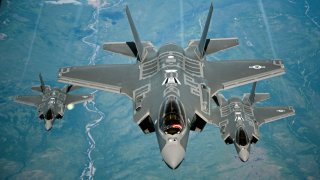The Next Stealth Fighters is Coming to Rule the Skies, Pilots Optional
The Air Force has already flown an aircraft operating with a manned pilot and AI-capable computerized co-pilot.
Here's What You Need to Remember: Given how little is known about the new sixth-generation fighter jet, one might not want to refer to “loyal wingman” technology as a foregone conclusion for it, yet the maturity of the technology for fifth-generation platforms such as the F-22 and F-35 jets would seem to make it highly unlikely that similar technology would be used for sixth-generation warplanes.
While some artificial intelligence (AI)-enabled autonomous jet fighter technology has performed quite well in dogfighting simulations against human pilots in air-to-air combat, many contend that human decision-making in air-combat cannot be accurately replicated and should not be replaced fully by machines. The Air Force has already experimented with an integration of the two and has already flown an aircraft operating with a manned pilot and AI-capable computerized co-pilot.
This concept, as Raytheon explains it, may indeed inspire developers to envision a tailorable, “optionally manned” platform, wherein a done would operate in a coordinated or even at times interchangeable way with manned aircraft.
The need for this kind of human-machine mixture is precisely why many envision a sixth-generation platform as something which could be “optionally manned” or assisted by a sixth-generation capable armed drone fighter jet intended to dogfight or engage in high-risk attacks under enemy fire.
“You may need a human in the aircraft and not when the threat dictates otherwise, and use AI to relay human mission level tasking to unmanned autonomous vehicles,” Jason Clark, the director for Raytheon Intelligence & Space's Advanced Mission Systems, said during a Raytheon event.
This would make a lot of sense in a number of respects, given that the Air Force’s “loyal wingman” concept is making rapid progress and now airborne. This means, perhaps not unlike the F-35 stealth fighter jet’s Multi-Function Advanced Data Link (MADL), sixth-generation platforms may be architected with some kind of target and data-sharing connectivity enabling expedited and highly efficient communications. With this kind of technology, there would be massively reduced latency because video feed surveillance data would not need to go through a ground control center but would rather be instantly exchanged, organized and analyzed from the cockpit of a manned sixth-generation fighter. This is the kind of technology very much on the radar with Raytheon innovators operating at the nexus between data processing and reducing sensor to shooter time, something of growing and crucial importance.
“Tactical platforms operating within future operational environments, because of the environment that they're operating in, and quite frankly, driven by the threat, will need very low latency capability to respond to operational mission needs,” Clark said
Given how little is known about the new sixth-generation fighter jet, one might not want to refer to “loyal wingman” technology as a foregone conclusion for it, yet the maturity of the technology for fifth-generation platforms such as the F-22 and F-35 jets would seem to make it highly unlikely that similar technology would be used for sixth-generation warplanes.
“There was always a debate whether we needed to even consider dogfighting anymore because if the system was put together appropriately, the fight would never actually go to the point which will drive you into a dogfight. That debate has been ongoing for decades, I think it will continue. But at the end of the day, as a previous fighter guy, you’re going to want to have the capability for any eventuality, and you've got to be ready to get into a dogfight if you go there,” Clark said.
The introduction of new forms of high-speed, AI-empowered computer processing also greatly enhances autonomy, something Raytheon innovators envision as fundamental to sixth-generation operational functionality. The F-35B fighter, for example, already operates with software designed to help pilots hover above and descend vertically onto the flight deck of amphibious assault ships in all kinds of maritime conditions.
“With auto-land technology, you can bring it all the way down to the back of the carrier without any pilot needing to be involved. My key prediction for the sixth generation aircraft will be their ability to land autonomously with precision in any weather or terrain conditions. The combination of the evolution of the aircraft auto-land technology, which has been around for a while with the proliferation of more precise reference signals, is what's going to make this a reality,” Marcelo Cavalcanti, the director of International Business Development for Raytheon Intelligence & Space, said during the webinar.
Meanwhile, the F-35C fighter jet operates with advanced software called “Delta Flight Path” which helps stabilize the trajectory and glide slope of a carrier landing, therefore improving the process for pilots.
“Today we are delivering precursor technology for when we land 6th-generation fighters on aircraft carriers. This technology uses high integrity differential GPS algorithms, encrypted communication signals, and inertial navigation sensors, all working together to enable jets to land on a small square on the back of an aircraft carrier with repeatable precision and accuracy,” said Conn Doherty, Senior director for Future Aircraft Systems & Technology Raytheon Intelligence & Space.
Kris Osborn is the defense editor for the National Interest. Osborn previously served at the Pentagon as a Highly Qualified Expert with the Office of the Assistant Secretary of the Army—Acquisition, Logistics & Technology. Osborn has also worked as an anchor and on-air military specialist at national TV networks. He has appeared as a guest military expert on Fox News, MSNBC, The Military Channel, and The History Channel. He also has a Masters Degree in Comparative Literature from Columbia University.
Image: Reuters.

